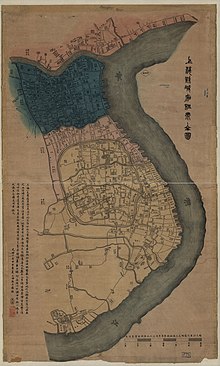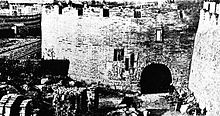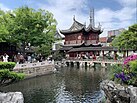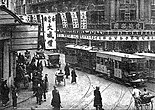
A | B | C | D | E | F | G | H | CH | I | J | K | L | M | N | O | P | Q | R | S | T | U | V | W | X | Y | Z | 0 | 1 | 2 | 3 | 4 | 5 | 6 | 7 | 8 | 9
Shanghai
上海 | |
|---|---|
| Municipality of Shanghai | |
Skyline of Lujiazui from Zhapulu Bridge | |
| Etymology: 上海浦 (Shànghăi pǔ) "The original name of the Huangpu River | |
 | |
 Location of Shanghai Municipality in China | |
| Coordinates (People's Square): 31°13′43″N 121°28′29″E / 31.22861°N 121.47472°E | |
| Country | China |
| Region | East China |
| Settled | c. 4000 BC[1][dubious ] |
| Establishment of - Qinglong Town | 746[2] |
| - Huating County | 751[3] |
| - Shanghai County | 1292[4] |
| - Municipality | 7 July 1927 |
| Municipal seat | Huangpu District |
| Divisions - County-level - Township- level |
|
| Government | |
| • Type | Municipality |
| • Body | Shanghai Municipal People's Congress |
| • CCP Secretary | Chen Jining |
| • Congress Chairwoman | Huang Lixin |
| • Mayor | Gong Zheng |
| • Municipal CPPCC Chairman | Hu Wenrong |
| • National People's Congress Representation | 57 deputies |
| Area | |
| • Municipality | 6,341 km2 (2,448 sq mi) |
| • Water | 653 km2 (252 sq mi) |
| • Metro | 14,922.7 km2 (5,761.7 sq mi) |
| Elevation | 4 m (13 ft) |
| Highest elevation | 118 m (387 ft) |
| Population (2022)[9] | |
| • Municipality | 26,875,500 |
| • Rank | 1st in China |
| • Density | 4,200/km2 (11,000/sq mi) |
| • Metro | 40,000,000 |
| • Metro density | 2,700/km2 (6,900/sq mi) |
| Demonym | Shanghainese |
| GDP[11] | |
| • Municipality |
|
| • Per capita |
|
| Time zone | UTC+08:00 (CST) |
| Postal code | 200000–202100 |
| Area code | 21 |
| ISO 3166 code | CN-SH |
| – Growth | |
| HDI (2021) | 0.880[12] (2nd) – very high |
| License plate prefixes |
|
| Abbreviation | SH / 沪 (Hù) |
| City flower | Yulan magnolia |
| Languages | |
| Website | |
Shanghai[a] is one of the four direct-administered municipalities of China. The city is located on the southern estuary of the Yangtze River, with the Huangpu River flowing through it. The population of the city proper is the third largest in the world, with around 29.2 million inhabitants in 2023, while the urban area is the most populous in China, with 39.3 million residents. As of 2022, the Greater Shanghai metropolitan area was estimated to produce a gross metropolitan product (nominal) of nearly 13 trillion RMB ($1.9 trillion).[15] Shanghai is one of the world's major centers for finance, business and economics, research, science and technology, manufacturing, transportation, tourism, and culture. The Port of Shanghai is the world's busiest container port.
Originally a fishing village and market town, Shanghai grew in importance in the 19th century due to both domestic and foreign trade and its favorable port location. The city was one of five treaty ports forced to open to European trade after the First Opium War which ceded Hong Kong to the United Kingdom, following the Second Battle of Chuenpi in 1841, more than 60 km (37 mi) east of the Portuguese colony of Macau that was also controlled by Portugal following the Luso-Chinese agreement of 1554. The Shanghai International Settlement and the French Concession were subsequently established. The city then flourished, becoming a primary commercial and financial hub of Asia in the 1930s. During the Second Sino-Japanese War, the city was the site of the major Battle of Shanghai. After the war, the Chinese Civil War soon resumed between the Kuomintang (KMT) and the Chinese Communist Party (CCP), with the latter eventually taking over the city and most of the mainland. From the 1950s to the 1970s, trade was mostly limited to other socialist countries in the Eastern Bloc, causing the city's global influence to decline during the Cold War.
Major changes of fortune for the city would occur when economic reforms initiated by paramount leader Deng Xiaoping during the 1980s resulted in an intense redevelopment and revitalization of the city by the 1990s, especially the Pudong New Area, aiding the return of finance and foreign investment. The city has since re-emerged as a hub for international trade and finance. It is the home of the Shanghai Stock Exchange, one of the largest stock exchanges in the world by market capitalization and the Shanghai Free-Trade Zone, the first free-trade zone in mainland China. Shanghai has been classified as an Alpha+ (global first-tier) city by the Globalization and World Cities Research Network. As of 2022, it is home to 12 companies of the Fortune Global 500 and is ranked 4th on the Global Financial Centres Index. The city is also a global major center for research and development and home to numerous Double First-Class Universities. The Shanghai Metro, first opened in 1993, is the largest metro network in the world by route length.
Shanghai has been described as the "showpiece" of the economy of China. Featuring several architectural styles such as Art Deco and shikumen, the city is renowned for its Lujiazui skyline, museums and historic buildings including the City God Temple, Yu Garden, the China Pavilion and buildings along the Bund, which includes Oriental Pearl Tower. Shanghai is also known for its cuisine, local language, and cosmopolitan culture, ranks sixth in the list of cities with the most skyscrapers, and it is one of the biggest economic hubs in the world.
Etymology
| Shanghai | |||||||||||||||||||||||||||||||||||||||||||
|---|---|---|---|---|---|---|---|---|---|---|---|---|---|---|---|---|---|---|---|---|---|---|---|---|---|---|---|---|---|---|---|---|---|---|---|---|---|---|---|---|---|---|---|
 "Shanghai" in regular Chinese characters | |||||||||||||||||||||||||||||||||||||||||||
| Chinese | 上海 | ||||||||||||||||||||||||||||||||||||||||||
| Hanyu Pinyin | Shànghǎi | ||||||||||||||||||||||||||||||||||||||||||
| Wu | |||||||||||||||||||||||||||||||||||||||||||
| Postal | Shanghai | ||||||||||||||||||||||||||||||||||||||||||
| Literal meaning | "Upon the Sea" | ||||||||||||||||||||||||||||||||||||||||||
| |||||||||||||||||||||||||||||||||||||||||||
The two Chinese characters in the city's name are 上 (shàng/zaon, "upon") and 海 (hǎi/hé, "sea"), together meaning "On the Sea." The earliest occurrence of this name dates from the 11th-century Song dynasty, when there was already a river confluence and a town with this name in the area. How the name should be understood has been disputed, but Chinese historians have concluded that during the Tang dynasty, the area of modern-day Shanghai was under sea level, so the land appeared to be literally "on the sea."[16]
Shanghai is officially abbreviated 沪[b] (Hù/wu) in Chinese, a contraction of 沪渎[c] (Hù Dú/wu-doq, "Harpoon Ditch"), a 4th- or 5th-century Jin name for the mouth of Suzhou Creek when it was the main conduit into the ocean.[19] This character appears on all motor vehicle license plates issued in the municipality today.[20]
Alternative names
申 (Shēn/sén) or 申城 (Shēnchéng/sén-zen, "Shen City") was an early name originating from Lord Chunshen, a 3rd-century BC nobleman and prime minister of the state of Chu, whose fief included modern Shanghai.[19] Shanghai-based sports teams and newspapers often use Shen in their names, such as Shanghai Shenhua and Shen Bao.
华亭[d] (Huátíng/gho-din) was another early name for Shanghai. In AD 751 during the mid-Tang dynasty, Huating County was established by Zhao Juzhen, the governor of Wu Commandery, at modern-day Songjiang, the first county-level administration within modern-day Shanghai. The first five-star hotel in the city was named after Huating.[21]
魔都 (Módū/mó-tu, "Magical City"), a contemporary nickname for Shanghai, is widely known among the youth.[22] The name was first mentioned in Shōfu Muramatsu's 1924 novel Mato, which portrayed Shanghai as a dichotomous city where both light and darkness existed.[23]
The city has various nicknames in English, including the "New York of China", in reference to its status as a cosmopolitan megalopolis and financial hub,[24] the "Pearl of the Orient", and the "Paris of the East."[25][26] This is similar to Ho Chi Minh City (also known as Saigon), in Vietnam, which has also been nicknamed as "Paris of the Orient," due to Vietnam's historical French status.[27]
History
Antiquity
The western part of modern-day Shanghai was inhabited 6,000 years ago.[28] During the Spring and Autumn period (approximately 771 to 476 BC), it belonged to the Kingdom of Wu, which was conquered by the Kingdom of Yue, which in turn was conquered by the Kingdom of Chu.[29] During the Warring States period (475 BC), Shanghai was part of the fief of Lord Chunshen of Chu, one of the Four Lords of the Warring States. He ordered the excavation of the Huangpu River. Its former or poetic name, the Chunshen River, gave Shanghai its nickname of "Shēn."[29] Fishermen living in the Shanghai area then created a fish tool called the hù, which lent its name to the outlet of Suzhou Creek north of the Old City and became a common nickname and abbreviation for the city.[30]
Imperial era
During the Tang and Song dynasties, Qinglong Town (青龙镇[e]) in modern Qingpu District was a major trading port. Established in 746 (the fifth year of the Tang Tianbao era), it developed into what was historically called a "giant town of the Southeast," with thirteen temples and seven pagodas. Mi Fu, a scholar and artist of the Song dynasty, served as its mayor. The port experienced thriving trade with provinces along the Yangtze and the Chinese coast, as well as with foreign countries such as Japan and Silla.[2] By the end of the Song dynasty, the center of trading had moved downstream of the Wusong River to Shanghai.[31] It was upgraded in status from a village to a market town in 1074, and in 1172, a second sea wall was built to stabilize the ocean coastline, supplementing an earlier dike.[32] From the Yuan dynasty in 1292 until Shanghai officially became a municipality in 1927, central Shanghai was administered as a county under Songjiang Prefecture, which had its seat in the present-day Songjiang District.[33]

Two important events helped promote Shanghai's developments in the Ming dynasty. A city wall was built for the first time in 1554 to protect the town from raids by Japanese pirates. It measured 10 m (33 ft) high and 5 km (3 mi) in circumference.[34] A City God Temple was built in 1602 during the Wanli reign. This honor was usually reserved for prefectural capitals and not normally given to a mere county seat such as Shanghai. Scholars have theorized that this likely reflected the town's economic importance, as opposed to its low political status.[34]
During the Qing dynasty, Shanghai became one of the most important seaports in the Yangtze Delta region as a result of two important central government policy changes: in 1684, the Kangxi Emperor reversed the Ming dynasty prohibition on oceangoing vessels—a ban that had been in force since 1525; and in 1732, the Qianlong Emperor moved the customs office for Jiangsu province (江海关;[f] see Customs House, Shanghai) from the prefectural capital of Songjiang to Shanghai, and gave Shanghai exclusive control over customs collections for Jiangsu's foreign trade. As a result of these two critical decisions, Shanghai became the major trade port for all of the lower Yangtze region by 1735, despite still being at the lowest administrative level in the political hierarchy.[35]
-
Songjiang Square Pagoda, built in the 11th century
-
The Mahavira Hall at Zhenru Temple, built in 1320
-
The walled Old City of Shanghai in the 17th century
Rise and golden age

In the 19th century, international attention to Shanghai grew due to European recognition of its economic and trade potential at the Yangtze. During the First Opium War (1839–1842), British forces occupied the city.[36] The war ended in 1842 with the Treaty of Nanking, which opened Shanghai as one of the five treaty ports for international trade.[37] The Treaty of the Bogue, the Treaty of Wanghia, and the Treaty of Whampoa (signed in 1843, 1844, and 1844, respectively) forced Chinese concession to European and American desires for visitation and trade on Chinese soil. Britain, France, and the United States all established a presence outside the walled city of Shanghai, which remained under the direct administration of the Chinese.[38]
The Chinese-held Old City of Shanghai fell to rebels from the Small Swords Society in 1853, but control of the city was regained by the Qing government in February 1855.[39] In 1854, the Shanghai Municipal Council was created to manage the foreign settlements. Between 1860 and 1862, the Taiping rebels twice attacked Shanghai and destroyed the city's eastern and southern suburbs, but failed to take the city.[40] In 1863, the British settlement to the south of Suzhou Creek (northern Huangpu District) and the American settlement to the north (southern Hongkou District) joined in order to form the Shanghai International Settlement. The French opted out of the Shanghai Municipal Council and maintained its own concession to the south and southwest.[41]

The First Sino-Japanese War concluded with the 1895 Treaty of Shimonoseki, which elevated Japan to become another foreign power in Shanghai. Japan built the first factories in Shanghai, which was soon copied by other foreign powers. All this international activity gave Shanghai the nickname "the Great Athens of China."[42] In 1914, the Old City walls were dismantled because they blocked the city's expansion. In July 1921, the Chinese Communist Party was founded in the French Concession.[38] On 30 May 1925, the May Thirtieth Movement broke out when a worker in a Japanese-owned cotton mill was shot and killed by a Japanese foreman.[43] Workers in the city then launched general strikes against imperialism, which became nationwide protests that gave rise to Chinese nationalism.[44]
The golden age of Shanghai began with its elevation to municipality after it was separated from Jiangsu on 7 July 1927.[38][45] This new Chinese municipality covered an area of 494.69 km2 (191.0 sq mi), including the modern-day districts of Baoshan, Yangpu, Zhabei, Nanshi, and Pudong, but excluded the foreign concessions territories.[45] Headed by a Chinese mayor and municipal council, the new city government's first task—the Greater Shanghai Plan—was to create a new city center in Jiangwan town of Yangpu district, outside the boundaries of the foreign concessions. The plan included a public museum, library, sports stadium, and city hall, which were partially constructed before being interrupted by the Japanese invasion.[46] In the 1920s, shidaiqu became a new form of entertainment and was popularised in Shanghai.[47]
The city flourished, becoming a primary commercial and financial hub of the Asia-Pacific region in the 1930s.[48] During the ensuing decades, citizens of many countries and all continents came to Shanghai to live and work; those who stayed for long periods—some for generations—called themselves "Shanghailanders."[49] In the 1920s and 1930s, almost 20,000 White Russians fled the newly established Soviet Union to reside in Shanghai.[50] These Shanghai Russians constituted the second-largest foreign community. By 1932, Shanghai had become the world's fifth largest city and home to 70,000 foreigners.[51] In the 1930s, some 30,000 Jewish refugees from Europe arrived in the city.[52]
-
Skyline of Shanghai Pudong at night, September 2021
-
Shanghai, filmed in 1937
-
The Bund in the late 1920s seen from the French Concession
-
Nanking Road (modern-day East Nanjing Road) in the 1930s
-
Shanghai Park Hotel was the tallest building in Asia for decades.
-
Former Shanghai Library
-
The HSBC Building, built in 1923, and the Customs House, built in 1927
Japanese invasion

On 28 January 1932, Japanese forces invaded Shanghai while the Chinese resisted. More than 10,000 shops and hundreds of factories and public buildings[53] were destroyed, leaving Zhabei district ruined. About 18,000 civilians were either killed, injured, or declared missing.[38] A ceasefire was brokered on 5 May.[54] In 1937, the Battle of Shanghai resulted in the occupation of the Chinese-administered parts of Shanghai outside of the International Settlement and the French Concession. People who stayed in the occupied city suffered on a daily basis, experiencing hunger, oppression, or death.[55] The foreign concessions were ultimately occupied by the Japanese on 8 December 1941 and remained occupied until Japan's surrender in 1945; multiple war crimes were committed during that time.[56]
A side-effect of the Japanese invasion of Shanghai was the Shanghai Ghetto. Japanese consul to Kaunas, Lithuania, Chiune Sugihara issued thousands of visas to Jewish refugees who were escaping the Nazi's Final Solution to the Jewish Question. They traveled from Keidan, Lithuania across Russia by railroad to the Vladivostok from where they traveled by ship to Kobe, Japan. Their stay in Kobe was short as the Japanese government transferred them to Shanghai by November 1941. Other Jewish refugees found haven in Shanghai, not through Sugihara, but came on ships from Italy. The refugees from Europe were interned into a cramped ghetto in the Hongkou District, and after the Japanese attack on Pearl Harbor, even the Iraqi Jews who had been living in Shanghai from before the outbreak of WWII were interned. Among the refugees in the Shanghai Ghetto was the Mirrer Yeshiva, including its students and faculty. On 3 September 1945, the Chinese Army liberated the Ghetto and most of the Jews left over the next few years.[57]
On 27 May 1949, the People's Liberation Army took control of Shanghai through the Shanghai Campaign. Under the new People's Republic of China (PRC), Shanghai was one of only three municipalities not merged into neighboring provinces (the others being Beijing and Tianjin).[58] Most foreign firms moved their offices from Shanghai to Hong Kong, as part of a foreign divestment due to the PRC's victory.[59]
Modernity

After the war, Shanghai's economy was restored—from 1949 to 1952, the city's agricultural and industrial output increased by 51.5% and 94.2%, respectively.[38] There were 20 urban districts and 10 suburbs at the time.[60] On 17 January 1958, Jiading, Baoshan, and Shanghai County in Jiangsu became part of Shanghai Municipality, which expanded to 863 km2 (333.2 sq mi). The following December, the land area of Shanghai was further expanded to 5,910 km2 (2,281.9 sq mi) after more surrounding suburban areas in Jiangsu were added: Chongming, Jinshan, Qingpu, Fengxian, Chuansha, and Nanhui.[61] In 1964, the city's administrative divisions were rearranged to 10 urban districts and 10 counties.[60]
As the industrial center of China with the most skilled industrial workers, Shanghai became a center for radical leftism during the 1950s and 1960s. The radical leftist Jiang Qing and her three allies, together the Gang of Four, were based in the city.[62] During the Cultural Revolution (1966–1976), Shanghai's society was severely damaged. The majority of the workers in the Shanghai branch of the People's Bank of China were Red Guards and they formed a group called the Anti-Economy Liaison Headquarters within the branch.[63]: 38 The Anti-Economy Liaison Headquarters dismantled economic organizations in Shanghai, investigated bank withdrawals, and disrupted regular bank service in the city.[63]: 38 The Shanghai People's Commune was established in the city during the January Storm of 1967. Despite the disruptions of the Cultural Revolutions, Shanghai maintained economic production with a positive annual growth rate.[38]
During the Third Front campaign to develop basic industry and heavy industry in China's hinterlands in case of invasion by the Soviet Union or the United States, 354,900 Shanghainese were sent to work on Third Front projects.[64]: xvi The centerpiece of Shanghai's Small Third Front project was the "rear base" in Anhui rear base which served as "a multi-function manufacturing base for anti-aircraft and anti-tank weaponry.[64]: xvi
Since 1949, Shanghai has been a comparatively heavy contributor of tax revenue to the central government; in 1983, the city's contribution in tax revenue was greater than investment received in the past 33 years combined.[65] Its importance to the fiscal well-being of the central government also denied it from economic liberalizations begun in 1978.
In 1990, Deng Xiaoping permitted Shanghai to initiate economic reforms, which reintroduced foreign capital to the city and developed the Pudong district, resulting in the birth of Lujiazui.[66] That year, the China's central government designated Shanghai as the "Dragon Head" of economic reform.[67] As of 2020, Shanghai is classified as an Alpha+ city by the Globalization and World Cities Research Network, making it one of the world's Top 10 major cities.[68]
In early 2022, Shanghai experienced a large outbreak of COVID-19 cases. After localized lockdowns failed to stem the rise in cases, the Chinese government locked down the entire city on 5 April. This resulted in widespread food shortages across the city emerged as food-supply chains were severely disrupted by the government's lockdown measures, which was not lifted until 1 June.[69]
Geography

Shanghai is located on the Yangtze Estuary of China's east coast, with the Yangtze River to the north and Hangzhou Bay to the south, with the East China Sea to the east. The land is formed by the Yangtze's natural deposition and modern land reclamation projects. As such, it has sandy soil, and skyscrapers have to be built with deep concrete piles to avoid sinking into the soft ground.[70] The provincial-level Municipality of Shanghai administers both the estuary and many of its surrounding islands. It borders the provinces of Zhejiang to the south and Jiangsu to the west and north.[71] The municipality's northernmost point is on Chongming Island, which is the second-largest island in mainland China after its expansion during the 20th century.[72] It does not administratively include an exclave of Jiangsu on northern Chongming or the two islands forming Shanghai's Yangshan Port, which are parts of Zhejiang's Shengsi County.
Shanghai is located on an alluvial plain. As such, the vast majority of its 6,340.5 km2 (2,448.1 sq mi) land area is flat, with an average elevation of 4 m (13 ft).[8] Tidal flat ecosystems exist around the estuary, however, they have long been reclaimed for agricultural purposes.[73] The city's few hills, such as She Shan, lie to the southwest, and its highest point is the peak of Dajinshan Island (103 m or 338 ft) in Hangzhou Bay.[8] Shanghai has many rivers, canals, streams, and lakes, and it is known for its rich water resources as part of the Lake Tai drainage basin.[74]
| Shanghai | ||||||||||||||||||||||||||||||||||||||||||||||||||||||||||||
|---|---|---|---|---|---|---|---|---|---|---|---|---|---|---|---|---|---|---|---|---|---|---|---|---|---|---|---|---|---|---|---|---|---|---|---|---|---|---|---|---|---|---|---|---|---|---|---|---|---|---|---|---|---|---|---|---|---|---|---|---|
| Climate chart (explanation) | ||||||||||||||||||||||||||||||||||||||||||||||||||||||||||||
| ||||||||||||||||||||||||||||||||||||||||||||||||||||||||||||
















